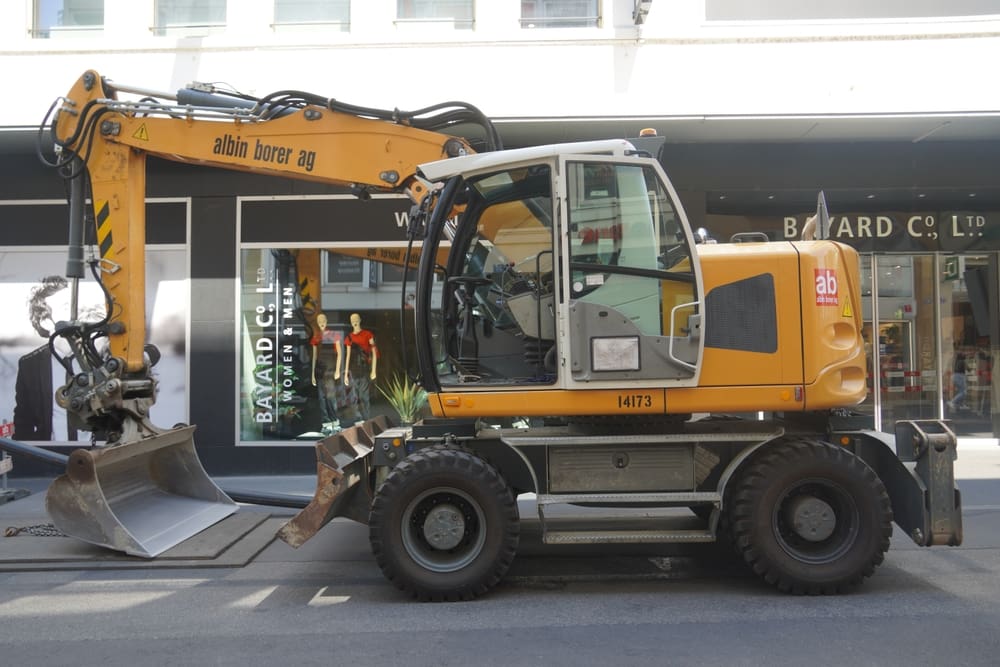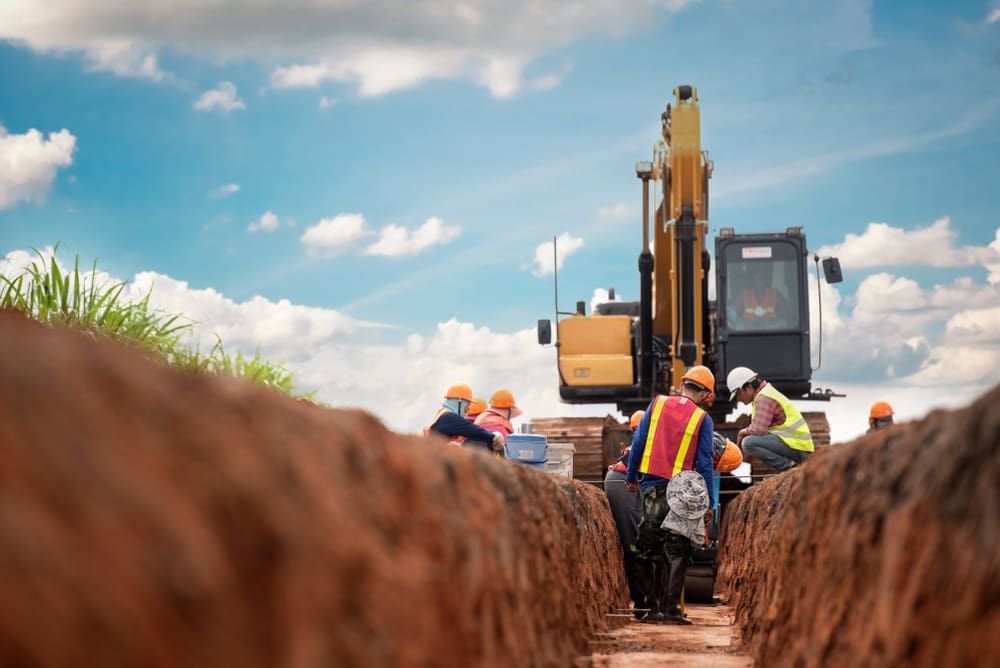Excavation is a core process across industries, including commercial construction, forestry, and dredging. Without it, work crews couldn’t lay foundations for new buildings, install utility lines, or build bridges and roads.
Whether you need help understanding the different excavation types or want to know which type of excavation is best for your project, Heavy Equipment Colleges (HEC) is here to help. Check out the guide below to learn all about excavators and their uses.
Table of Contents
What Are Excavators?
Excavators are vital pieces of heavy equipment used to remove and transfer materials to lay foundations, dig trenches, and more. These machines feature a boom, arm, bucket, and cab that sit atop an undercarriage consisting of either wheels or a track system. Specialized tools—including hydraulic breakers, cutters, shears, grapples, and couplers—can be attached to the unit to perform specific functions.
Excavators are primarily used for digging, lifting, and carrying and vary in style, size, and weight. They’re classified by either the type of material they extract or the purpose of excavation, and different models are used for different types of excavation.
Why We Need Excavators
When you see the term “excavator,” various questions likely pop into your head—questions like what they’re used for and how to operate an excavator. Those are the questions we’re here to address.
Excavator operators use these machines to remove, lift, and transport materials between locations on a construction site. Without them, we wouldn’t have the bridges, skyscrapers, and grocery stores we have today.

Excavator Size Classifications
Excavators are classified into three categories. Let’s take a closer look at the different types of excavators.
1. Compact Excavators - Mini to Midi
Compact excavators, which range in size from mini to midi, are designed for projects that take place in small or tight spaces, given their smaller size and optimal maneuverability. They help equipment operators achieve precision for tasks like digging holes to plant trees.
Mini Excavators:
Mini excavators are relatively small, typically weighing less than five metric tons. This makes them easier to transport and operate as well as ideal for soft terrain because they don’t damage nearby pavements. Mini excavators are intended for small-scale projects involving minimal lifting and hauling.
Midi Excavators:
Midi excavators are a bit larger and heavier, weighing between five and ten metric tons. As a result, midi excavators are more powerful, enabling them to lift and transport more weight than mini excavators.
2. General Purpose Excavators - Medium
The majority of excavators used today are medium, general-purpose excavators. That’s because these powerful machines can be used for various tasks and are compatible with most attachment tools.
Although they weigh anywhere from five to 25 metric tons, they’re easier to maneuver. However, the heavier the excavator, the more damage it will cause to the ground below. As a result, they’re not recommended for use on soft terrain. Their larger size means they have greater tail swing during rotation, making them unfit for use in small or tight spaces.

3. General Purpose Excavators - Large
Large, general-purpose excavators weigh more than 25 metric tons and are designed for heavy-duty projects involving large quantities of materials that weigh a lot. Because of this, they’re used most frequently on commercial construction sites and large demolition projects.
But bigger isn’t always better. Although these excavators can carry more weight, they can be difficult to transport and maneuver.
What Is Excavation?
Excavation is the removal of soil, rocks, or other materials from the ground. It prepares a work site for the construction of buildings, roads, and other infrastructure. It can also take the form of mining, material handling, dredging, trenching, forestry, demolition, or drilling. Excavation also:
-
Enhances the efficiency of drainage and utility systems, minimizing the risk of water damage and erosion to the pavement above
-
Makes spaces safer and more accessible
10 Types of Excavation
1. Topsoil Excavation: Before a foundation can be laid or pipelines installed, the top layer of soil must be removed. When starting a project, you should mark the area that will be excavated—a process known as ground tracing—to guide you along the way. Then, you can extract topsoil to its required depth.
2. Rock Excavation: Some soil contains rocks or even boulders that must be removed before construction can take place. Heavy-duty excavators remove and relocate these obstructions.
3. Footing Excavation: Every foundation needs footings to stabilize it, protecting the building from sinking or collapsing after installation. Factors such as ground settlement, freezing, and thawing make a building more likely to sink or collapse over time. Excavation must be performed to dig trenches for the footings.
4. Earth Excavation: This process removes the spoil, the soil layer directly below the topsoil. It consists of soil, dirt, and rubble. The spoil is used to construct embankments, foundations, bridges, and ditches.
5. Cut and Fill Excavation: This type of excavation involves removing the topsoil and spoil to use for embankments, raised sections of land, and foundation filling.
6. Trench Excavation: Trench excavation resembles footing excavation, with the main difference being that trench excavation works for more applications. For example, it can be used to dig trenches for pipe and sewer line installations. Shallow trenches are less than 19 feet deep, while deep trenches are 19 feet or deeper. Trenching must occur in stages to prevent them from collapsing.

7. Dredge Excavation: Dredging removes dirt, sediment, and debris from the bottom of bodies of water to allow boats and other vessels to travel without obstructions.
8. Muck Excavation: Muck consists of soil and water. It’s found on many construction sites and must be extracted before work begins to ensure a stable foundation. The muck can either be moved to another location or spread over the ground nearby to dry.
9. Basement Excavation: Basement excavation involves digging a large area of soil and dirt below ground level for the installation of basements and other underground structures.
10. Borrow Excavation: Borrow excavation occurs when a job requires you to bring materials from another site—rather than remove existing materials—to complete a project. It’s often used to level or backfill formerly excavated areas. Common borrowed materials include soil, sand, and gravel.
Why Is Excavation Practiced?
Heavy equipment operators use excavation to achieve a specific purpose, whether that be constructing infrastructure, office buildings and manufacturing facilities, parking lots, or something else. Excavation is important because it allows us to build new structures for public and private use.
Key Differences Between an Excavator and a Digger
Although excavators and diggers both remove soil and other materials from the ground to build foundations, dig trenches, and form large holes, they’re not the same pieces of equipment. Choosing the right machine for your project depends largely on the intended application.
Excavators
- Can rotate up to 360 degrees
- Feature a long arm with a bucket attached to one end
- Are ideal for major construction projects
- Are less powerful but easier to maneuver
Diggers
- Can only rotate up to roughly 220 degrees in either direction
- Feature a wide bucket attached directly to the machine
- Are designed for smaller construction projects
Are more powerful but more difficult to maneuver
Become a Licensed Excavator Operator at HEC
Are you ready to start your career as an excavator operator? Enroll in excavator training courses at HEC to gain the knowledge and hands-on experience that can help land the job you want. As one of the nation’s leading heavy equipment schools, we know how to get students like you to the next level.
Don’t wait to pursue the future you want. Enroll in a heavy equipment training program today to complete your training in as little as three weeks.
Build a Strong Future in Heavy Equipment Operation
Train to Operate Excavator Safely and Confidently
Real-World Experience | Expert Instructors | Career-Focused Training
Enroll in Our Excavator Operator Program Today!
Start Enrollment ProcessFind The Right Location For You
